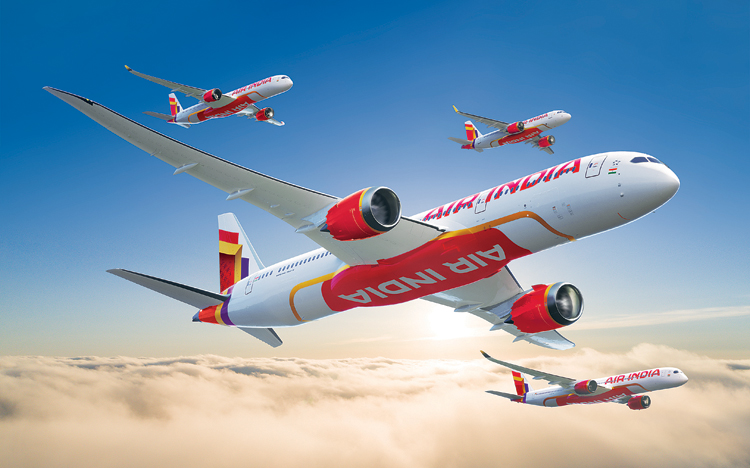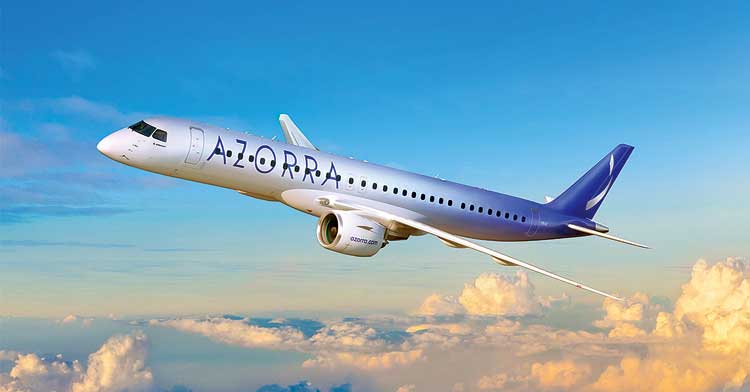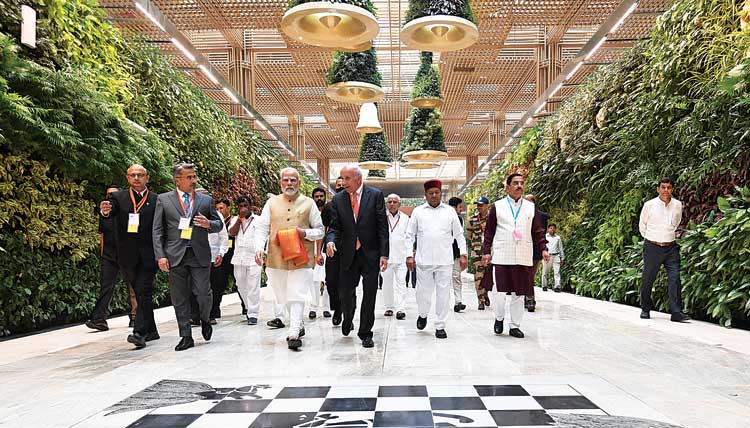INDIAN ARMED FORCES CHIEFS ON
OUR RELENTLESS AND FOCUSED PUBLISHING EFFORTS

SP Guide Publications puts forth a well compiled articulation of issues, pursuits and accomplishments of the Indian Army, over the years

I am confident that SP Guide Publications would continue to inform, inspire and influence.

My compliments to SP Guide Publications for informative and credible reportage on contemporary aerospace issues over the past six decades.
A High-Flying Year
During 2023, the aviation industry continued to fly high despite challenges like shortage of skilled personnel, escalating fuel prices, regulatory constraints, and airport capacities

The year 2023 turned out to be a landmark year for civil aviation, witnessing a flurry of orders and deals at major global airshows. These agreements have set an optimistic tone for the aviation industry, pointing towards a promising ascent in the times to come. With new airlines coming in; some old airlines’ consolidating, turning towards refurbishing their fleet and regional aviation seeing a growth, India too had an interesting year. Expected to surpass previous records by the close of 2024, the Indian aviation sector foresees substantial growth, fueled by significant aircraft orders from major carriers such as Air India and IndiGo this year. While challenges like a shortage of skilled personnel, escalating fuel prices, regulatory constraints, and airport capacities persist, the industry sees vast opportunities.
Sustainability took center stage with a surge in commitments to sustainable aviation fuels (SAFs). Urban air mobility (UAM) progressed, witnessed in global cities with test flights of electric vertical takeoff and landing (eVTOL) aircraft. Despite pandemic challenges, airlines pursued ambitious fleet expansions and announced new routes, fostering recovery. Airports embraced digital transformation, introducing smart technologies for enhanced passenger experiences, while safety and security remained paramount.
AIRSHOW EXTRAVAGANZA
While many events happened across the globe in 2023, the Paris Air Show, Dubai Air Show and Aero India were among the top headline makers.
The International Paris Air Show marked its triumphant return for the 54th edition after a four-year hiatus due to the COVID-19 pandemic, attracting global aviation enthusiasts, industry leaders, and trade visitors. The show featured 2,500 companies from 46 countries, including 300 startups. A recordbreaking 322 official delegations, ministers, and chiefs of staff attended, drawing 3,00,000 visitors and showcasing over $150 billion in contracts.
The Dubai Airshow’s 18th edition brought together 1,400 exhibitors from 95 countries. With 350+ speakers, 80+ startups, and 190+ aircraft displays, the event highlighted innovations and deals, particularly in the Middle East.

Aero India 2023 hosted 98 countries with a focus on showcasing indigenous capabilities, demonstrating India’s prowess in the aerospace sector and laid the groundwork for substantial collaborations and advancements.
DEALS THAT SEALED AMBITION, HOPE
Many large scale orders and deals were witnessed at these shows that gave a significant push to the civil aviation industry. Some of the major fixed wings deals from this year have been highlighted here.
Airbus Soars into the Future
- In a sweeping move toward modernisation, Qantas finalised an order for nine A220-300s with Airbus, marking a strategic step in its comprehensive fleet replacement.
- Philippine Airlines strengthened its collaboration with Airbus, solidifying an MoU for the acquisition of nine A350-1000s. This decision sets the stage for the replacement of its existing 777-300ERs, earmarking these new aircraft for ultra-long-haul journeys.
- The Baltic skies are set to see significant transformation as Air Baltic committed to expanding its fleet with a firm order for 30 Airbus A220-300s, boosting its total order to an impressive 80 aircraft.
- Simultaneously, EgyptAir embraced the Airbus A350-900, securing 10 aircraft scheduled for delivery in 2025.
- Emirates took center stage with a remarkable expansion of its A350 fleet, adding 15 more A350-900s to reach a grand total of 65. Ethiopian Airlines contributed to the momentum with an order for 11 A350-900s, consolidating the A350 backlog at 33.
- Air Arabia, underscoring its commitment to operational prowess, made a substantial move by ordering 240 CFM Leap-1A engines. This strategic decision aligns with its Airbus A320neo family aircraft, shaping the future of its fleet.
- Air Cairo, in a bid for sustained service excellence, formalised a multi-year service agreement for 28 Leap engines, bolstering the operational backbone of its A320neo fleet.
- Air India emerged as a headline-maker at the airshow, signing a monumental contract for up to 250 Airbus aircraft. Driven by the imperative to replace aging planes and expand the fleet, the deal includes a mix of Airbus A320neo, A321neo, and A350-1000s.
- The largest single aircraft order placed by any airline with Airbus was made by the Indian low-cost carrier IndiGo, who ordered 500 members of the A320 family. Delivery will start in 2030 and last until 2035. The order includes a mix of twinjet models A320neo, A321neo, and A321XLR.
- In a parallel development, Pratt & Whitney secured a 10-year agreement with Emirates, solidifying its commitment to maintain and support the airline’s 116 PW980 auxiliary power units (APUs) installed on its Airbus A380 fleet.
Boeing’s Triumph and Collaborative Milestones
- China Airlines is set to elevate its fleet dynamics, exercising options to incorporate eight Boeing 787s, a strategic move embedded in a broader agreement inked last year.
- Aviation leasing giant Avolon rekindled its engagement with Boeing, ordering 40 of the fuel-efficient 737-8 model, aligning with its commitment to a more sustainable and economical portfolio. In tandem, Air Algérie bolsters its Boeing narrowbody family, confirming an order for eight 737-9 MAX jets, emphasising their increased capacity and extended range.
- Boeing, amassed orders, options, and purchase rights approaching an astounding $100 billion. Among the highlights were significant orders from Emirates Airline, securing ninety 777Xs and five 787 Dreamliner widebodies, and FlyDubai, adding thirty 787s to its fleet.
- Boeing’s success reverberated with contracts from carriers including Scat Airlines, SunExpress Airlines, EgyptianAir, Royal Jordanian, and Royal Air Maroc.
- Air India took center stage by signing a monumental contract for up to 290 new Boeing jets. This comprehensive deal, driven by the imperative to replace aging planes and expand the fleet, includes a diverse mix of Boeing’s 737 MAX, 787s, and 777Xs.
- Boeing and Akasa Air announced an order for four additional 737-8 jets. India’s regional carrier, Star Air has leased four E175s in 2022 and two of them have started operations since May 2023.
- Emirates made a resounding entrance with a substantial $52 billion procurement of Boeing aircraft. Safran, in turn, secured contracts exceeding $1.2 billion from Emirates, encompassing seats for the new Airbus A350 and Boeing 777X-9 aircraft. This significant export order spans Business, Premium Economy, and Economy classes, underscoring the airline’s commitment to passenger comfort and luxury.
- Oman Air ventured into dedicated cargo operations by welcoming its first 737-800 Boeing Converted Freighter, marking a strategic leap into the realm of cargo transport.
- In a collaborative thrust, CFM joined forces with Flydubai, cementing an agreement for 222 Leap-1B turbofans. This collaboration strategically supports Flydubai’s Boeing 737
- fleet, ensuring operational efficiency and technological advancement in the realm of aviation propulsion.
Embraer echoes growth too
- In a significant upswing for Embraer’s aircraft portfolio, Azorra has placed an order for 15 E195-E2 single-aisle aircraft, contributing a substantial boost to Embraer’s order backlog.
- Simultaneously, Avolon has engaged in a strategic sale and leaseback agreement with Porter Airlines, securing ten additional E195-E2 aircraft, further fortifying Embraer’s standing in the aviation market.
- Embraer’s success story continued with American Airlines making a pivotal addition. The airline has placed an order for seven E175 models, earmarked for its regional affiliate, Envoy Air. This strategic move aligns with American Airlines’ commitment to expanding its regional fleet with Embraer’s cutting-edge E175s. The collaborative momentum between Embraer and its partners underscores the aircraft manufacturer’s prowess in meeting the evolving needs of the aviation industry.
ATR Secures Impressive Orders and Expands Partnerships
- ATR, a prominent turboprop manufacturer, placed a total of 22 firm orders and two additional options, encompassing both its ATR 72 and ATR 42 turboprop models.
- Taiwan’s Mandarin Airlines took the lead with an order for six ATR 72-600s, while Berjaya Air opted for two ATR 72-600s configured entirely for business class.
- Brazil’s Azul added to ATR’s triumph by expressing intent to acquire three more ATR 72-600s, solidifying its commitment to the efficiency and reliability of ATR turboprops. ATR’s accomplishments further extended to contracts with five undisclosed customers, resulting in orders for eight ATR 72-600s and three ATR 42s.
- In a separate development, Abelo made a significant commitment to enhance its fleet by securing up to 20 ATR 72-600 aircraft. The initial firm order for 10 aircraft, coupled with options for an additional 10, underscores Abelo’s confidence in ATR’s turboprop technology and sets the stage for expanded regional connectivity.
The aviation landscape of 2023, as reflected in these significant events, stands as a testament to the industry’s resilience and innovation in the face of evolving challenges. These developments not only set the stage for technological advancements but also underline the collaborative spirit that drives the global aviation community toward new horizons.
INDIA’S REGIONAL ROUTE
The Regional Connectivity Scheme (RCS) - UDAN (Ude Desh Ka Aam Nagrik), a pivotal part of India’s National Civil Aviation Policy, celebrated six years of operation. Launched by the Ministry of Civil Aviation (MoCA) in 2016, UDAN aims to enhance air connectivity, especially in remote areas. Over this period, it has facilitated travel for more than 130 lakh passengers. UDAN has evolved through versions like 1.0, 2.0, 3.0, and 4.0, and recently launched 5.0, 5.1, and 5.2, each enhancing connectivity and operational flexibility. The ongoing bidding for UDAN 5.2 aims to further boost connectivity in remote areas, fostering growth in the civil aviation industry. Notably, the scheme has spurred the emergence of four successful airlines in the last six years, creating a conducive ecosystem for the aviation business.

The RCS-UDAN initiative has significantly improved regional air connectivity, linking previously underserved airports in remote areas of India. Across five bidding rounds, 517 routes have commenced operations, connecting 76 airports, including 9 Heliports and 2 Water Aerodromes. This has created more than 130 city pairs, with 2.47 lakh flights transporting over 130 lakh passengers. The scheme provides concessions such as exemption from landing and parking charges, discounted Route Navigation and Facilitation Charges, and the freedom for airline operators to enter code-sharing arrangements. Additionally, state governments at RCS Airports are encouraged to reduce VAT on Aviation Turbine Fuel and provide various support services for the sustainable development of regional air connectivity.
SUSTAINABILITY
Sustainability has been a key area of discussion and showcase of technologies for it have been showcased in most of these global events and even in India.
MoCA is driving initiatives to attain carbon neutrality and net-zero carbon emissions at Indian airports. The focus involves standardising the carbon accounting and reporting framework for airports. Airport operators are advised to map carbon emissions and work toward carbon neutrality and net-zero emissions progressively. The directive extends to upcoming Greenfield Airports and state governments, urging them to achieve carbon neutrality and net-zero, emphasising the use of green energy. Notably, airports like Delhi, Mumbai, Hyderabad, and Bengaluru have achieved high-level Airports Council International (ACI) accreditation, reaching carbon neutrality. Moreover, 66 Indian airports operate on 100 per cent green energy.
As we bid farewell to 2023, the civil aviation landscape reflects a dynamic industry evolving with the times. From sustainability commitments to technological marvels, the year witnessed the aviation sector’s resilience and determination to shape a future that is efficient, sustainable, and interconnectedness. With the above mentioned happening and more, these have set the stage for an exciting journey into the future of flight.





